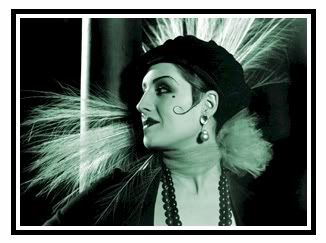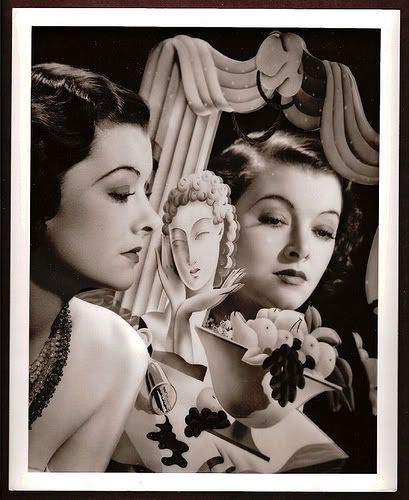
Of all the hundreds of movies I've seen in my lifetime, none have had so lasting an appeal as has
Fantasia, Disney's animated classic from 1940. When
Fantasia was released on VHS in celebration of its 50th anniversary, I was fortunate enough to receive a copy. It was one of those videos I watched countless times--I was absolutely mesmerized by the marriage of sounds and visuals. This movie remains a cornerstone of my development--It's no stretch of the imagination to say that my love of music began with
Fantasia. Furthermore, I think that the geneses of many of my interests and obsessions can be traced back to this film.
Essentially,
Fantasia is a series of music videos that feature some of the great works of Classical music and the best animation the industry had to offer at the time. It was an evolution of Disney's
Silly Symphonies, a series of cartoons identical in format to Fantasia, albeit on a much more moderate scale. The soundtrack was recorded by Leopold Stokowski and the Philadelphia Orchestra, and features eight selected pieces which represent a variety of styles and composers.
Bach's
Toccata and Fugue in D Minor is the first piece presented. Although Bach originally composed the piece for the pipe organ, Stokowski arranged it for an orchestral performance, and the result is one of the best renditions of
Toccata and Fugue that you will likely ever hear. The visual accompaniment to the music a series of abstract images and shapes; in effect, it is something of a spiritual predecessor to the modern day visualizer. It may sound boring, but it is actually quite effective--it serves as proof that you needn't associate music with any concrete images in order for it to be moving and engrossing to hear. Of course, as the introduction explains to us, that is the whole point of this segment.
The second piece is Tchaikovsky's
Nutcracker Suite, most of which will be familiar to the modern listener thanks to countless versions of the music having been included in Christmas-themed movies, cartoons and commercials. In
Fantasia, however, the music is set to a collection of scenes which illustrate the cycle of the seasons--specifically, the transition from summer to autumn to winter. The animation is absolutely top-notch in these sequences, and they are among the most visually striking and appealing sequences in the entire film. Although it is something a departure from Tchaikovsky's originally Christmas-themed ballet, this is nevertheless an excellent take on one of the most famous and beloved ballets ever written.
Next we have a somewhat abridged version of
The Sorcerer's Apprentice by French composer Paul Dukas. Although this is the most famous sequence from the film (thanks in no small part to the appearance of cartoon icon Mickey Mouse), it is actually one of the scenes I like the least. I liked it well enough when I was a rugrat, but it hasn't really stood up well to the test of time. The animated aspect of the sequence is good enough, but the music just doesn't do it for me. I've never been a big fan of French classical music anyway.
Stravinsky's
The Rite of Spring was intended to evoke a primitive and savage atmosphere. That it literally caused a riot at its 1913 premiere is evidence of how successful it was in that intention. Disney's accompaniment to the piece keeps that spirit quite intact, depicting the violent birth of the planet and the evolution (
in your face, creationists!) of life from single-celled organisms into lumbering, reptilian behemoths. This was one of my favorite sequences when I was a kid, if only because it had dinosaurs--the battle between the Tyrannosaurus and the Stegosaurus kept me riveted to the screen, even after having seen it three dozen times. Sadly, like
The Sorcerer's Apprentice, I find that I like this sequence significantly less now--the music is too atonal, and dinosaurs just aren't as cool as they were when I was a kid.
Next is a brief interlude which includes an intermission, followed by a jazzy jam-session and a sequence wherein the viewer is introduced to a variety of instruments. For me, this probably the least interesting part of the film, so much so that I would usually fast-forward through it. It's a bit more interesting now that I know more about music, but it's still not one of
Fantasia's best moments.
Fortunately, our patience for sitting through the intermission is rewarded with a sequence set to Beethoven's Sixth Symphony, entitled
Pastorale. The music is set to a scene from the pages of Greco-Roman mythology, complete with fauns, centaurs, Pegasuses (or rather Pegasi?) and pudgy Bacchus mounted on a unicorn-donkey hybrid (who is given the amusing name of Jacchus). Everything is all fun and frolicking until Zeus crashes the party, bringing along a dopey-looking Hephaestus to keep him supplied with thunderbolts. Everyone scatters for cover as Zeus bombards the landscape with his lightning, but eventually the deity gets tired and decides to hit the celestial hay. It wouldn't be too far from the truth to say that this part of
Fantasia is what sparked my interest in the Classical World, eventually leading me to pursue a degree in Classical Studies. Thanks a lot, Walt Disney. I blame you for everything.
The penultimate sequence features a variety of animals dancing to Amilcare Ponchielli's
Dance of the Hours. It's a fun and enjoyable scene, but not anything spectacular. Of particular interest, however, are the Art Deco doors that open to begin this sequence and come crashing down to close it. It might be a bit of stretch, but one could argue that those doors planted the seeds of my current obsession with Art Deco (along with
King Kong and
Who Framed Roger Rabbit?, but those are matters for other posts).

Fantasia concludes on a two-part sequence which features Modest Mussorgsky's
Night on Bald Mountain and Schubert's version of
Ave Maria. The first part of this concluding chapter was and is my favorite part of
Fantasia--in an astoundingly well-drawn and animated sequence, a devil-like being who roosts atop a mountain peak overlooking a village awakens from his slumber and summons forth the spirits of the dead from their graves. Chernabog--as this devil is called--is one of the coolest characters ever dreamed up by Disney; this guy is the entire reason why I think demons are so cool. We see that once night falls, Chernabog holds sway over all--he casts his shadow over the town, twisting the houses and buildings into evil caricatures of themselves, and plays with the dead souls as though they were little more than a set of macabre Legos. It's as though Disney was trying to capture the essence of evil itself on film, and this is probably as close as anyone has ever come to doing so (fun fact: Chernobog was an actual deity in the Slavonic pagan pantheon, and his name quite literally means "Black God").
This being Disney, however, the forces of evil must inevitably succumb to the forces of good. That being said, no other Disney movie has presented this idea in such an effective and truly beautiful fashion as does
Fantasia. Chernabog's dark ritual is brought to an end by a light from the sky, and he is forced to seek shelter beneath his wings as the night begins to give way to day. A procession of pious townsfolk passes from the town and through a nearby forest, eventually ending with the sunrise. It's a surprisingly profound meditation on the victory of light over darkness, and of life over death. If all of this seems fraught with Christian undertones... well, it is. But the whole concept is presented in so earnest a fashion that one simply cannot help but be moved by it. I'll be honest: I was bored to tears by this concluding number when I was a kid. But after having seen some of the world, and having learned quite a lot about religion, I find that now I can truly appreciate its message.
If you still have any doubts at this point, let me assuage them for you: I love this damn movie. Yet as much as I love it, audiences back in 1940 were not nearly so receptive. To be perfectly honest, the movie bombed. This, however, shouldn't come as a surprise--given the nature of cinema in 1940,
Fantasia seems very much like an art-house picture. If you expected a musical to be successful in 1940, you needed to have someone like Fred Astaire or Eleanor Powell dancing around. It was not until after the Film had be re-edited and re-released several times that audiences began to recognize
Fantasia for the classic it truly was. To make a tired point,
Fantasia is one of my favorite movies ever. If you haven't seen this picture yet, watch it. If you have seen it, watch it again. It really is that good.
 Today marks the 106th anniversary of the birth of Dorothy Sebastian. I let the date go by without celebration last year, and Dorothy appeared to me in a dream and scolded me for missing her birthday (actually, she was scolding me for killing a cat earlier in the dream, but I'm sure she meant to get on my case about the birthday thing, too).
Today marks the 106th anniversary of the birth of Dorothy Sebastian. I let the date go by without celebration last year, and Dorothy appeared to me in a dream and scolded me for missing her birthday (actually, she was scolding me for killing a cat earlier in the dream, but I'm sure she meant to get on my case about the birthday thing, too).







